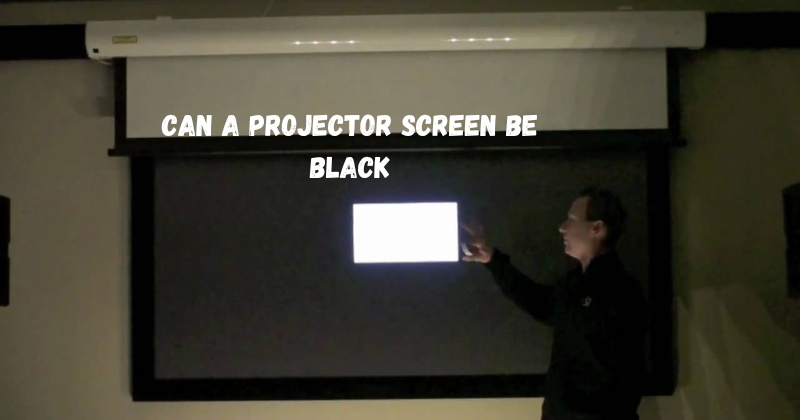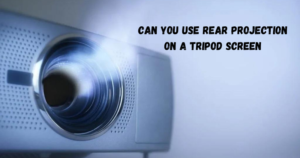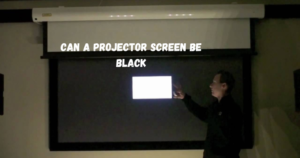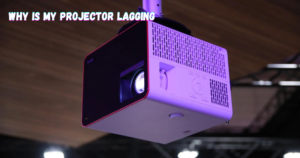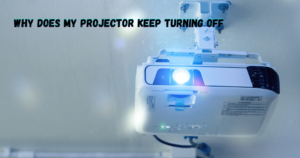Can a projector screen be black? This seemingly straightforward question leads us into the intriguing realm of display technology and the principles of projection. Traditionally, projector screens are designed to be white or light gray to maximize brightness and image clarity. However, the concept of a black projector screen challenges these norms and raises questions about its feasibility and practicality.
In this exploration, we will delve into the possibilities and limitations of using a black projector screen. We will examine the science behind projection, the role of screen color in image quality, and the potential benefits and drawbacks of a black projection surface. As we unravel the mysteries of projector screens and their color choices, we will gain a deeper understanding of the factors that contribute to an immersive and high-quality viewing experience. So, let’s begin our journey into the world of projection and screen colors.
The Science Behind Projection
To understand whether a projector screen can be black, we must first understand how projectors work and how they create an image. A projector is a light source that projects an image onto a surface using lenses and mirrors. The process begins with the projection device producing light that is then focused by the lenses and directed toward the screen. The image itself is created through a process called additive color mixing, where red, green, and blue light combine to produce a full-color image.
The brightness and image contrast of the projected image depend on various factors, such as the light source, optics, and projection surface. This brings us to the next crucial element in the projection process – the screen.
The Importance of Screen Color
The color of a projection screen plays a significant role in the overall image quality. As mentioned earlier, traditional screens are white or light gray to maximize brightness and contrast. This is because white reflects all colors of light equally, making it an ideal surface for projecting images.
A white projector screen also helps to mitigate the effects of ambient light, making the image appear brighter and more vivid. Gray screen also option in projector screens arena. Gray projector screens have contrast ratio better than white screens. Gray screens can also work for purposes such as presentations due to better viewing angles.
On the other hand, black projector screens absorbs most of the light that falls on it and reflects very little. So, using a black screen for projection might seem counterintuitive. A black projector screen could potentially enhance the contrast and perceived dynamic range of the image, leading to more vivid and lifelike visuals.
Can A Projector Screen Be Black?
The answer to this question is complex. While technically possible, using a black projector screen comes with several limitations and challenges. First and foremost, a black surface would significantly reduce the overall brightness of the projected image. As mentioned earlier, white surfaces reflect more light, which helps to produce brighter images. On the other hand, using a black screen would absorb most of the light, resulting in a dimmer and less vibrant image.
Moreover, using a black projector screen would require a significantly brighter projection device to compensate for the loss of brightness. This could lead to increased power consumption and potential overheating issues. Additionally, ambient light would have a more significant impact on the projected image, potentially causing glare and reducing overall image quality.
Why a Black Projector Screen Is a Game-Changer
Despite the limitations and challenges, the concept of a black projector screen continues to intrigue many in the projection community. As technology advances, we are seeing innovations that could make this idea a reality. For example, there are now high-contrast projectors that can produce brighter images on dark surfaces. This means that using a black projector screen would no longer result in significant brightness issues.
Another aspect to consider is the use of ambient light-rejecting (ALR) screens. These screens are designed to reflect and diffuse incoming light in a specific direction, making them ideal for environments with high levels of ambient light. Using an ALR screen with a black surface could potentially eliminate the issues of glare and reduce the impact of ambient light on the projected image.
How a Black Projector Screen Elevates the Home Theater Experience
One of the most intriguing possibilities of a black projector screen is its potential to enhance the home theater experience. With a darker background, images could appear more dynamic and lifelike, making for a truly immersive viewing experience. So, explore the below points to learn how a black projector screen could elevate your home theater setup:
Contrast and Image Quality
The Importance of Contrast
Contrast is one of the most crucial elements in image quality. It refers to the difference between the lightest and darkest areas of an image, with higher contrast leading to a more vibrant and detailed picture. Using a black projector screen could enhance contrast by providing a darker background for images, making them stand out more.
The contrast ratio is a measure of the difference between the brightest and darkest areas of an image. With a black screen, contrast ratios could potentially be improved, leading to more vivid and detailed images. The projector’s brightness settings would also be optimized for a black screen, leading to overall better image quality.
Color Accuracy
Another potential benefit of using a black projector screen is improved color accuracy. With a white screen, colors may appear washed out or distorted due to the ambient light reflected off the surface.
On the other hand, using a black screen could provide better color contrast and depth, leading to more accurate and vibrant colors. High contrast screens can also improve color accuracy by reducing the effect of ambient light and improving the overall viewing experience.
Impact on Image Quality
In addition to contrast, using a black projector screen could also improve other aspects of image quality. As mentioned earlier, a black background could potentially enhance perceived color accuracy and dynamic range. It could also reduce the visibility of imperfections in the projection surface, leading to a smoother and more seamless viewing experience.
Enhancing the Viewing Experience
When it comes to home theater setups, many people strive for a cinematic experience. A black projector screen could help achieve this by creating a darker environment that further immerses viewers in the action on screen. In addition, with advancements in technology and the use of ALR screens, the issues of brightness and ambient light can be effectively managed. Bright image projections on a dark screen could result in truly stunning visuals that elevate the overall viewing experience.
Ambient Light Considerations
Dealing with Ambient Light
One of the main challenges of using a projector is managing ambient light. This includes both natural and artificial light sources that can impact the projected image, causing glare and reducing overall image quality. However, with a black projector screen, ambient light could have less of an impact since it absorbs most of the light instead of reflecting it.
Managing Glare and Reflections
Glare and reflections are common issues when using projection technology. They can be distracting and reduce the overall viewing experience. With a black projector screen, these issues could be mitigated since the dark surface would absorb and diffuse incoming light instead of reflecting it.
DIY Black Projector Screen – Is It Worth It
Many people are interested in creating a DIY black projector screen instead of purchasing one. While this may seem like a cost-effective option, it has its drawbacks. The process of creating a black surface that can effectively reflect the projected image while absorbing ambient light requires precision and expertise. This means that there is a risk of ending up with an inferior product that performs differently than expected.
Furthermore, the materials and tools needed for a DIY black projector screen can add up in cost, making it less economical than initially thought. It is also essential to consider the time and effort required to create such a screen, which may not be worth it for some individuals.
How to Choose the Right Black Projector Screen
Here are some points to consider when selecting a black projector screen:
- Screen Material: Look for screens specifically designed for high contrast and ambient light rejection. These will have the necessary properties to effectively reflect the projected image while absorbing ambient light.
- Viewing Environment: Consider the amount of ambient light in your viewing environment and choose a screen with an appropriate gain level. A higher gain means more light is reflected, making it suitable for brighter environments.
- Projector Compatibility: Ensure that the screen is compatible with your projector and has the necessary brightness and contrast capabilities to produce high-quality images on a black surface.
Pros and Cons of a Black Projector Screen
We are explaining some advantages and disadvantages of using a black projector screen:
Pros
- Enhanced contrast and perceived dynamic range
- Potential improvement in color accuracy
- Immersive home theater experience
- Mitigates the effects of ambient light
Cons
- Reduced overall brightness of images
- Requires a significantly brighter projection device
- Potential for increased power consumption and overheating issues
- Limited availability of high-contrast projectors and ALR screens with black surfaces.
FAQs
Can projectors show true black?
Projectors cannot produce true black as they rely on a light source. However, with the use of a black projector screen, images can appear much darker and closer to true black.
Is a black projector screen worth it for gaming?
A black projector screen could enhance the gaming experience by providing better contrast and color accuracy, but it may not be necessary for all players. It is ultimately a personal preference and depends on the individual’s viewing environment.
Why is my projector just showing a black screen?
There could be various reasons for a projector showing a black screen, such as an incorrect input source, damaged or loose cables, or a faulty projector. Ensure that all connections are secure and check the input source to troubleshoot the issue. If the problem persists, it may require professional assistance.
Can I use a black sheet for the projector screen?
Using a black sheet may not produce the desired results as it may not have the necessary properties to reflect the projected image correctly. It is recommended to use a screen specifically designed for projection purposes.
Conclusion
In conclusion, the concept of a black projector screen is a fascinating departure from conventional wisdom in display technology. While traditional screens are predominantly white or light gray to optimize image brightness, our exploration has shown that a black projector screen, while technically possible, comes with significant trade-offs. It can enhance contrast and reduce ambient light reflection, making it suitable for specific applications like home theaters and low-light environments.
However, it sacrifices overall image brightness and color accuracy. Ultimately, the choice of a black projector screen depends on the specific use case and personal preferences. This journey into the world of projector screens highlights the importance of a balance between image quality and environmental considerations.
